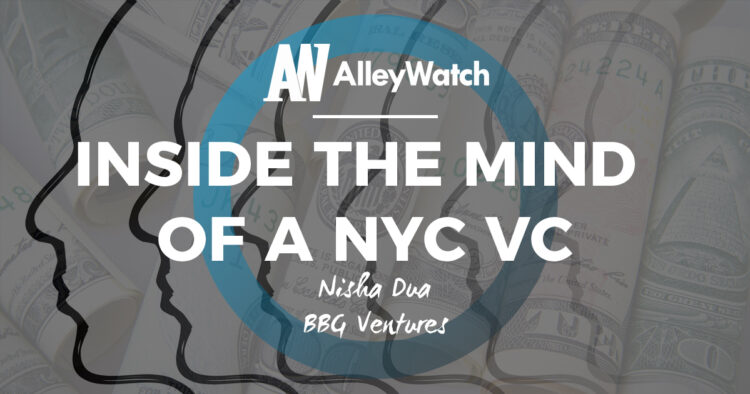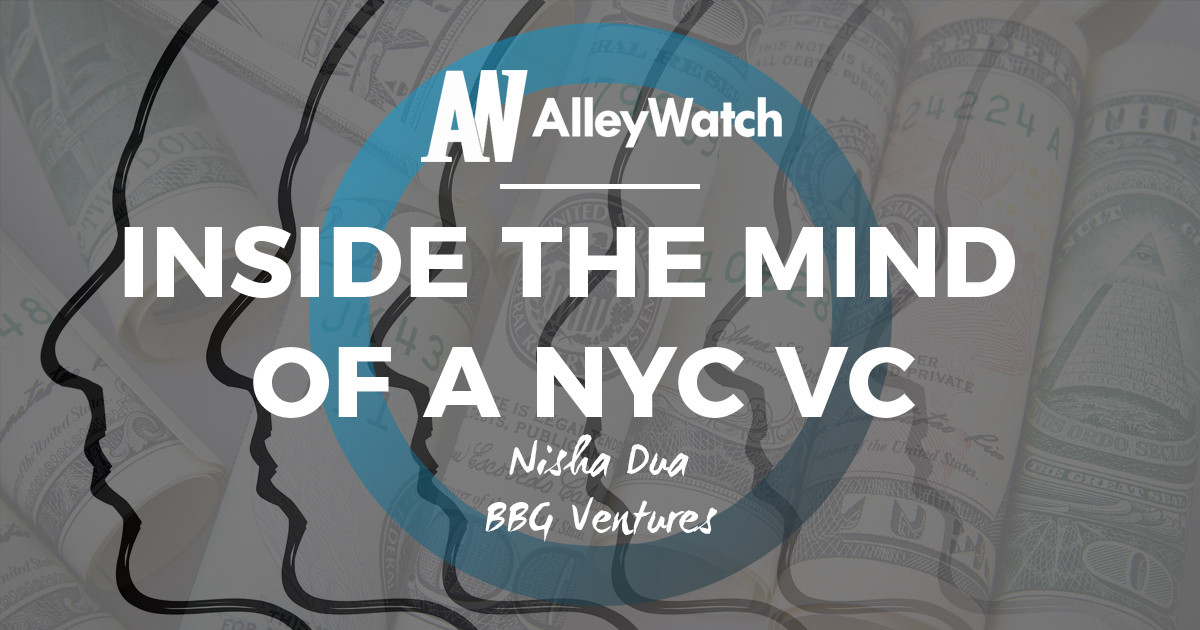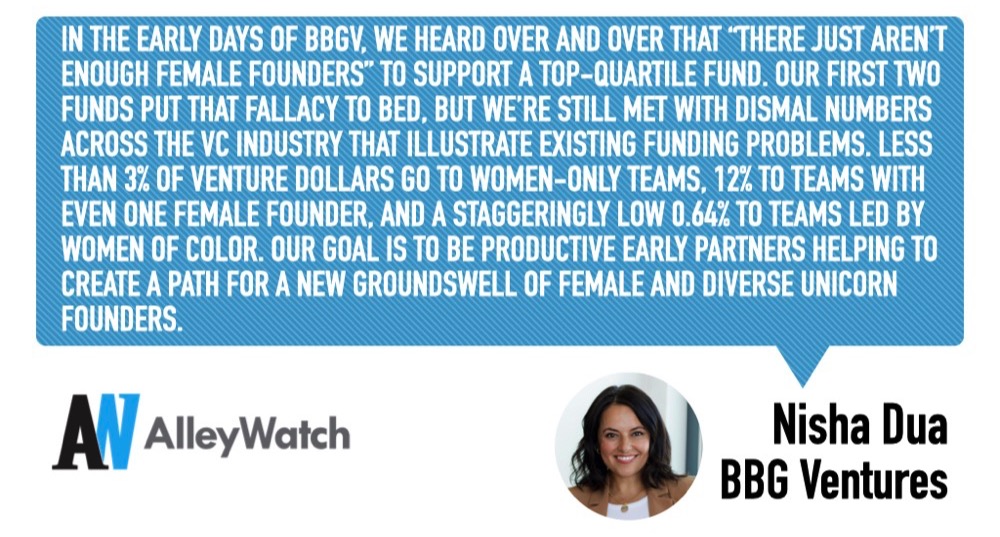Welcome back to Inside the Mind of an NYC VC, a highly acclaimed series at AlleyWatch in which we speak with leading New York City-based Venture Capitalists. Today we sit down with Nisha Dua, Cofounder and Managing Partner at BBG Ventures, an early-stage venture firm investing in consumer tech startups with at least one female founder. BBG, spun out of AOL in 2014, is one of the earliest NYC firms to identify that gender-diverse teams provide outsized returns in venture. The firm is presently investing out of its recently-closed $50M third fund, its first institutional fund. BBG’s portfolio companies are led by founders that have a deep and unique understanding of their markets and include Spoon University, HopSkipDrive, Spring Health, Winky Lux, Zola, Shine, goTenna, LOLA, Goby, Mighty Networks, and GLAMSQUAD.
Nisha was kind enough to provide some insight into her path to venture, the state of diversity in venture and entrepreneurship, how BBG’s first two funds and stellar track record have validated the investment thesis, actionable tips for founder pitches, the evolving state of the consumer market, and much, much more.
If you are a NYC-based VC interested in participating in this series, please send us an email. We’d love to chat.
Reza Chowdhury, AlleyWatch: Please tell us a little bit about background and how you started in venture.
Nisha Dua, BBG Ventures: My career has been nonlinear, but I’ve always focused on building dynamic businesses and seeing the power of young female consumers. I was a recovering M&A lawyer and former Bain consultant when Susan Lyne brought me on as her first hire at AOL (Susan is a cofounder of BBGV). At AOL, I oversaw strategy & operations for the 1,300-person, 40 brand group and reconceptualized AOL’s millennial website, Cambio. I also launched BUILT BY GIRLS, a leading platform for young women in tech that algorithmically matches high school students and professionals to give female and non-binary talent their first connections in the tech world.
Over our time at AOL, Susan and I kept advising an ever-growing number of founders with countless stories about the challenge of raising capital. At that time in New York, tech advances like cloud storage, iOS, and open-source software had dramatically lowered the cost of launching a startup, opening the door to many new founders who were still overlooked by the traditional venture world. This, paired with the deal flow already coming our way, and the stats around lack of funding going to female founders, made us realize the huge untapped opportunity in front of us to back a new wave of founders. We felt certain that our operating backgrounds would give us a unique capacity to support early-stage companies. We launched our first $10M fund in 2014 with the support of AOL, and have met with almost 8,000 companies since we launched.
The firm just recently closed its third fund, which is its first institutional fund with outside LPs. What was that fundraising process like for this? What factors about the fund do you believe led your limited partners to invest?
The vast majority of the VC landscape is focused on a non-diverse and outdated founder model and because of this, overlooks businesses with significant potential for high returns. Even since we launched our first fund, there has continued to be a major whitespace for investors leading rounds for female-led companies. This time around, we knew we needed an institutional-sized fund, and set out to attract a more diverse array of institutional backing and stakeholders. We spun out from AOL/Verizon Media for this third fund and earned backing from institutional LPs (State of Michigan Retirement Services), family offices (George Kaiser), strategic corporates (Verizon), and individuals who bring strong operational experience (including a host of female founders like Payal Kadakia, Shan-Lyn Ma, Tracey Sun).
 Our new LPs were attracted to this fund because they believe in our thesis about the changing face of today’s consumer – and that a more diverse group of founders are better equipped to accommodate their needs. Women are expected to control two-thirds of US consumer wealth within the next 10 years and spending power trends are shifting rapidly: Black, Asian American and Latinx spending power is $4.3T, Gen Z will take over Millennials as the largest generation in 2023 and there are 55M Americans over 65 years-old who are living longer and spending more. We understand the increasing intersectionality of consumers and actively seek out founders who inherently understand their target customer. LPs are increasingly aware that emerging managers like us can tap into the new wave of founders.
Our new LPs were attracted to this fund because they believe in our thesis about the changing face of today’s consumer – and that a more diverse group of founders are better equipped to accommodate their needs. Women are expected to control two-thirds of US consumer wealth within the next 10 years and spending power trends are shifting rapidly: Black, Asian American and Latinx spending power is $4.3T, Gen Z will take over Millennials as the largest generation in 2023 and there are 55M Americans over 65 years-old who are living longer and spending more. We understand the increasing intersectionality of consumers and actively seek out founders who inherently understand their target customer. LPs are increasingly aware that emerging managers like us can tap into the new wave of founders.
In addition, as former operators of both public companies and startups and now lead investors, we coach and work very closely with founders on the challenges they face as managers. We advise on everything – from PR to hiring to brand review – and spend a lot of time on milestones, storytelling, and introductions for Series A when the time comes. Our investment thesis, the breadth of our experience, and proven track record makes BBGV stand out amidst similar funds in the industry.
Any tips that you can offer for emerging fund managers?
On dealflow: Commit to expanding your network beyond your existing circles. One of our strongest investments in the new fund came from our website’s general contact page, and we’ve made it a priority to take as many meetings with people of color from cold outreach. Diverse founders will drive outsized returns by addressing the challenges and needs of overlooked and emerging consumers – if you don’t try to expand your networks, you’ll miss those opportunities.
On building a firm: Spend time with experienced managers you respect who play at the same stage as you. This will help you refine your portfolio construction, level up your firm operations, and have go-to advisors for when you get those inevitable “this is the first time I’ve ever experienced this” questions.
What have you learned since launching back in 2014? Tell us about the experience of building a VC brand. What mistakes did you make early on?
Two things have really stood out for me: First, what you do for founders is more important than what you tweet. Run your own race and work hard to help them succeed. If you do that, your brand will emerge organically. What people say when you aren’t there – that’s the brand that matters. Second, there will always be another deal – don’t let the ones that got away define what you’re building.
What’s the specific investment thesis that BBG Ventures deploys? Where is the firm’s sweet spot?
BBGV leads pre-seed and seed-stage rounds in women-led companies that will reshape the way we live. We look for founders who are building scalable solutions to problems that millions of people face – and that the founder understands firsthand. We typically write $500K-$1M checks, anywhere across the US. While we have a strong presence in NY/SF, our most recent investments were in San Diego and Milwaukee.
Since the firms’ founding in 2014, the diversity landscape has unquestionably changed. What are your observations? What challenges remain?
In the early days of BBGV, we heard over and over that “there just aren’t enough female founders” to support a top-quartile fund. Our first two funds put that fallacy to bed, but we’re still met with dismal numbers across the VC industry that illustrate existing funding problems. Less than 3% of venture dollars go to women-only teams, 12% to teams with even one female founder, and a staggeringly low 0.64% to teams led by women of color. Our goal is to be productive early partners helping to create a path for a new groundswell of female and diverse unicorn founders.
What impact has COVID had on the funding environment and your workflow?
Of course, there was a lot of certainty in the first few months of 2020 as the impacts of the pandemic rippled across industries. In spite of concerns about
female founders not starting companies, we tracked a higher deal flow (up 24% YoY) for the period Sept 2019 to Sept 2020 and 17% YoY from April 2020 to Sept 2020. As terrible as the pandemic has been, there are hopeful shoots emerging in its wake and we feel strongly there is significant opportunity for reinvention across industries that will kick off a decade of accelerated change.
What are you excited about right now, from an investment standpoint?
We’re focused on large categories demanding transformation by new consumers, such as health and wellbeing; the future of education and work; climate-friendly commerce; products for overlooked and emerging consumers. We’ve been tracking these industries for years, but the pandemic has definitely highlighted the opportunity in some of the biggest areas of consumer spending. Telehealth, remote learning, and conscious consumerism are a few we think will only grow from here.
Since most of the firm’s investments are on the consumer end, what do you look for in a consumer play, and how do you gain comfort about investing in what is ultimately a hit-driven industry?
We invest in consumer brands where we see the convergence of a truly differentiated, 10X better product, values that align with new consumer preferences, and a distribution advantage. We do less and less pure DTC consumer companies, but that direct-to-consumer and community relationship will always be important whatever the consumer business model – which is why we single out the founders who intuitively understand their end-user and can best cater to a more diverse array of challenges and needs.
What is one thing that many founders are missing, not emphasizing enough, or not aware of when pitching?
At BBGV, we always look for compelling storytellers who have the ability to communicate – why this product, why now, why them. That skill translates to not just attracting investors, but to recruiting a team, building partnerships, and getting their product into the hands of the most consumers. We weigh a founder’s vision and ability to execute highly when considering their pitch but often are ultimately convinced by a founder’s ability to drive the narrative of their work forward.
At BBGV, we always look for compelling storytellers who have the ability to communicate – why this product, why now, why them. That skill translates to not just attracting investors, but to recruiting a team, building partnerships, and getting their product into the hands of the most consumers. We weigh a founder’s vision and ability to execute highly when considering their pitch but often are ultimately convinced by a founder’s ability to drive the narrative of their work forward.
As the New York tech ecosystem has evolved over the last few years, access to capital has improved for founders but not all capital is the same. What should entrepreneurs be looking for in an investor?
Entrepreneurs should always think a few steps ahead – and one of the biggest hurdles for founders is growing into a manager and CEO as they scale their business. The best investors will offer more than just capital: they will help entrepreneurs evolve into leaders and offer the resources and connections needed to prepare for the next phase of business, whether it’s the Series A raise or operations.
Quick Hits:
Finish this sentence – in 10 years, the NYC Startup ecosystem will be…
More diverse. While the stats from last year were troubling, I’m encouraged by the number of new funds emerging led by diverse managers. We know that diverse managers fund diverse founders – the trickle-down effect is coming.
What’s your prediction for when NYC starts to resemble the pre-pandemic city?
It’s already happening and will only continue as more people get vaccinated. Folks are looking at deals on office space, I had my first in-person meeting today, and a group of VCs set up a Happy Hour for a hundred people in tech later this month. People may have taken a break in Miami but they are back. New York never dies.
What’s the one investment that got away?
FIGS (which just filed for IPO), the healthcare apparel brand.
When’s the best piece of content that you consumed during the pandemic?
For work: How to Avoid a Climate Disaster by Bill Gates. For rest: I May Destroy You, written by and starring Michaela Coel on HBO.






